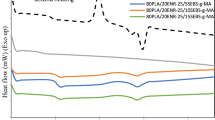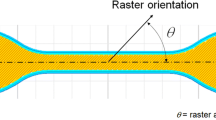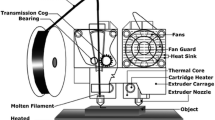Abstract
A series of ethylene-vinyl acetate/natural rubber (EVA/NR)-based thermoplastic elastomer (TPE) blends were developed for fused deposition modelling (FDM)-3D printing application. Two types of the EVA, namely EVA20 (17–20% vinyl acetate) and EVA24 (24–27% vinyl acetate), were used. The grafted EVA was blended with NR in various ratios using a melt blending approach. The effect of EVA/NR blends ratios were studied for thermal, melt flow index, mechanical and dynamic properties. Differential Scanning Calorimetry (DSC) analysis showed that increasing the NR ratio decreased the crystallinity of EVA/NR blends. Similarly, the melt flow index, hardness and tensile strength also reduced as NR content increased in the EVA blends. Printability study indicated that both EVA20 and EVA24 with their blends experienced buckling problems due to insufficient strength and stiffness for acting as push rods for the filament extrusion. Further investigation revealed that the elastic modulus (E') and loss modulus (E'') of EVA/NR blend was lower indicating lower stiffness and viscous response compared to commercial Thermoplastic Urethane and Nylon filaments. The feasibility study of EVA/NR blend in 3D printing provide fresh insight to develop TPE blends as potential 3D printing materials, especially involving natural rubber.









Similar content being viewed by others
References
Kazmer D (2017) Three-dimensional printing of plastics. In: Kutz M (ed) Applied plastics engineering handbook, 2nd edn. Elsevier Inc, pp 617–634
Przybytek A, Kucińska-Lipka J, Janik H (2016) Thermoplastic elastomer filaments and their application in 3D printing. Elastomery 20(4):32–39
Raveverma A, Periyasamy L (2017) The feasibility of SBR/EVA and TPU/PCL composite material for fused deposition modelling. Master Thesis, Universiti Tun Hussein Onn Malaysia.
Lukić M, Clarke J, Tuck C, Whittow W, Wells G (2016) Printability of elastomer latex for additive manufacturing or 3D printing. J Appl Polym Sci 133(4):1–7
Dudek P (2013) FDM 3D printing technology in manufacturing composite elements. Arch Metall Mater 58(4):1415–1418
Lehmann A, Ehrmann A, Finsterbusch K (2017) Optimization of 3D printing with flexible materials. In: International textile conference, Stuttgart, Germany, 30 November–1 December 2017
Lay M, Thajudin NLN, Hamid ZAA, Rusli A, Abdullah MK, Shuib RK (2019) Comparison of physical and mechanical properties of PLA, ABS and nylon 6 fabricated using fused deposition modeling and injection molding. Compos B Eng 176:107341
Advantages and Possibilities of Soft, Elastic Materials in 3D Printing (2020). www.pollen.am. Accessed 9 Dec 2020
Kumar N, Jain PK, Tandon P, Mohan Pandey P (2018) 3D printing of flexible parts using EVA material. Mater Phys Mech 37(2):124–132
Koshy AT, Kuriakose B, Thomas S, Varhese S (1993) Studies on the effect of blend ratio and crosslinking system on thermal, X-ray and dynamic mechanical properties of blends of natural rubber and ethylene-vinyl acetate copolymer. Polym 34(16):3428–3436
Intharapat P (2009) Thermoplastic natural rubbers based on natural rubber (NR) and ethylene vinyl acetate copolymer (EVA) with natural rubber-graft-poly (dimethyl (methacryloyloxymethyl) phosphonate)(NR-g-PDMMMP) as compatibilizer. PhD thesis, Le Mans University
Henderson AM (1993) General review of ethylene-vinyl acetate (EVA) copolymer. IEEE Electr Insul Mag, AT Plastic Inc 9:3038
Lee J-K, Lee T-Y, Ha C-S, Lee J-O (1994) Mechanical properties of dynamically vulcanized NR and EVA blends in a roll mill. Polym Korea 18:61–61
Jansen P, Soares BG (1996) Effect of compatibilizer and curing system on the thermal degradation of natural rubber/EVA copolymer blends. Polym Degrad Stab 52(1):95–99
Ismail H, Munusamy Y, Jaafar M, Ratnam CT (2008) Preparation and characterization of ethylene vinyl acetate (EVA)/natural rubber (SMR L)/organoclay nanocomposites: effect of blending sequences and organoclay loading. Polym Plast Technol Eng 47(8):752–761
Raveverma P, Ibrahim M, Sa’ude N, Yarwindran M, Nasharuddin M (2017) Mechanical behaviour study on SBR/EVA composite for FDM feedstock fabrication. In: AIP Conference proceedings, Vol 1. AIP Publishing, p 020011
Shi XM, Zhang J, Jin J, Chen SJ (2008) Non-isothermal crystallization and melting of ethylene-vinyl acetate copolymers with different vinyl acetate contents. Express Polym Lett 2(9):623–629
Sefadi JS, Luyt AS (2012) Morphology and properties of EVA/empty fruit bunch composites. J Thermoplast Compos Mater 25(7):895–914
Spoerk M, Holzer C, Gonzalez-Gutierrez J (2020) Material extrusion-based additive manufacturing of polypropylene: a review on how to improve dimensional inaccuracy and warpage. J Appl Polym Sci 137(12):48545
Yong MK, Ismail H, Ariff ZM (2007) Comparison properties of natural rubber (SMR L)/ethylene vinyl acetate (EVA) copolymer blends and epoxidized natural rubber (ENR-50)/ethylene vinyl acetate (EVA) copolymer blends. Polym Plast Technol Eng 46(4):361–366
Wang S, Capoen L, D’hooge DR, Cardon L, (2018) Can the melt flow index be used to predict the success of fused deposition modelling of commercial poly (lactic acid) filaments into 3D printed materials? Plast Rubber Compos 47(1):9–16
Adrianza JAC (2016) Thermodynamic study of the ethylene -vinyl acetate copolymer (EVA) solution separation process. PhD thesis, Universidad Complutense de Madrid.
Riecker S, Hein SB, Studnitzky T, Andersen O, Kieback B (2017) 3D printing of metal parts by means of fused filament fabrication — A non beam-based approach. In: International powder metallurgy congress and exhibition (Euro PM2017), Milan, Italy, 1–5 October 2017
Koshy AT, Kuriakose B, Thomas S, Premalatha CK, Varghese S (1993) Melt rheology and elasticity of natural rubber—ethylene-vinyl acetate copolymer blends. J Appl Polym Sci 49(5):901–912
Ariffin A, Ariff ZM, Jikan SS (2011) Evaluation on extrudate swell and melt fracture of polypropylene/kaolin composites at high shear stress. J Reinf Plast Compos 30(7):609–619
Venkataraman N, Rangarajan S, Matthewson MJ, Harper B, Safari A, Danforth SC, Wu G, Langrana N, Guceri S, Yardimci A (2000) Feedstock material property–process relationships in fused deposition of ceramics (FDC). Rapid Prototyp J 6(4):244–252
Turner BN, Strong R, Gold SA (2014) A review of melt extrusion additive manufacturing processes: I. Process design and modeling. Rapid Prototyp J 20(3):192–204
Ajinjeru C, Kishore V, Lindahl J, Sudbury Z, Hassen AA, Post B, Love L, Kunc V, Duty C (2018) The influence of dynamic rheological properties on carbon fiber-reinforced polyetherimide for large-scale extrusion-based additive manufacturing. Int J Adv Manuf Syst 99(1–4):411–418
George KE, Komalan C, Kumar PAS, Varughese KT, Thomas S (2007) Dynamic mechanical analysis of binary and ternary polymer blends based on nylon copolymer/EPDM rubber and EPM grafted maleic anhydride compatibilizer. Express Polym Lett 1(10):641–653
Acknowledgements
We thank the Malaysian Rubber Board for funding the project under the ISTC grant (S19ITE0708). The assistance of Ahmad Hamri Ibrahim in the sample mixing, rheological and 3D printing testing, as well as Mohamad Khairul Abdul Razak for the DMTA test and Mohd Haffiz Mohd Jabar for the 3D printing support are gratefully acknowledged. The authors would also like to thank G-TACR, Malaysia, for providing DSC laboratory service.
Author information
Authors and Affiliations
Corresponding author
Ethics declarations
Conflict of interest
The author(s) declared no conflicts of interest with respect to the research and publication of this article.
Additional information
Publisher's Note
Springer Nature remains neutral with regard to jurisdictional claims in published maps and institutional affiliations.
Rights and permissions
About this article
Cite this article
Abang Ismawi Hassim, D.H., Nik Ismail, N.I., Sarkawi, S.S. et al. The feasibility of using ethylene-vinyl acetate/natural rubber (EVA/NR)-based thermoplastic elastomer as filament material in fused deposition modelling (FDM)-3D printing application. J Rubber Res 24, 659–668 (2021). https://doi.org/10.1007/s42464-021-00145-0
Received:
Accepted:
Published:
Issue Date:
DOI: https://doi.org/10.1007/s42464-021-00145-0




